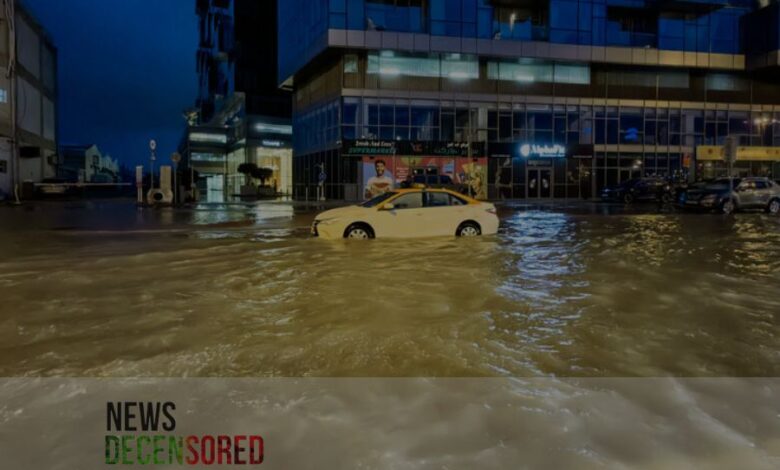Heaviest Rainfall in 75 years creates chaos in UAE and Oman: Floods, Flight Cancellations, and Climate Change Concerns

The United Arab Emirates (UAE) has been grappling with the aftermath of a historic downpour, the most severe in the country’s recorded history dating back 75 years. Within 24 hours, some areas received 250 millimeters (almost 10 inches) of rain, transforming the normally arid landscape into chaos.
Flooded Streets and Disrupted Lives
The relentless rain triggered widespread flooding, uprooting palm trees, shattering building facades, and inundating streets. Dubai, a popular tourist destination, bore the brunt of the storm’s fury. Flights were canceled as the airport struggled with flooded runways and terminals. Traffic came to a standstill, paralyzing the city’s transportation network. Schools were forced to close, further disrupting daily routines.
The sheer volume of rain was mind-boggling. Dubai International Airport, a global aviation hub, receives around 100 millimeters of rain annually. But in this single event, the downpour surpassed that amount in 12 hours. The sudden deluge left many motorists stranded as floodwaters transformed roads into raging rivers, forcing them to abandon their vehicles.
Climate Change and Extreme Weather
The UAE’s experience is a stark reminder of the growing threat of climate change. A warming atmosphere acts like a giant sponge, holding more moisture that ultimately falls as intense precipitation events like this. Scientists warn that such extreme weather occurrences are likely to become more frequent and severe in the future.
The storm was part of a more extensive weather system impacting the Arabian Peninsula. Oman, a neighboring country, also experienced heavy rain and flash floods, tragically claiming the lives of at least 18 people, including schoolchildren. Similar weather patterns brought unusually wet conditions to Iran and Pakistan.
The UAE itself suffered casualties, with a 70-year-old man perishing after floodwaters swept away his vehicle. The storm’s path shifted eastward, impacting southern Iran and Pakistan, regions typically seeing minimal rainfall during this time of year. The Iranian city of Chabahar received a staggering 130 mm of rain.
In Dubai, commuters faced a nightmare scenario. Many attempting to reach the city center found themselves stranded on flooded highways. Taxi drivers refused fares due to impassable roads, leaving passengers stuck on major arteries. People were seen wading through giant puddles, desperately seeking alternative modes of transportation. Some of these stranded individuals were international visitors attending a major conference in Dubai.
Shocking videos captured the surreal sight of Dubai International Airport, recently ranked the world’s second busiest, submerged underwater.
Due to ongoing delays and diversions, the airport advised passengers to only travel if absolutely necessary. Emirates, the UAE’s flagship airline, suspended check-in for departing flights until Thursday due to operational challenges caused by the weather. This situation created chaos for the millions of passengers who travel through the UAE’s airports annually.
Social Media Captures the Chaos
Social media platforms overflowed with footage showcasing the devastation. Videos captured furniture flying off balconies and strong currents washing away restaurant furniture in the Dubai Marina. Images depicted traffic gridlocked on significant roads, luxury cars submerged in the Business Bay district, and a flooded Dubai Metro station forcing commuters to wade through water.
Delivery services ceased operations, leaving many Dubai residents confined to their homes due to impassable streets. Some residents were even seen resorting to using canoes to navigate flooded neighborhoods. Viral videos documented residents wakeboarding on a flooded street and water rushing through a major shopping mall.
Climate Concerns
Officials refuted rumors that cloud seeding, a technique used to induce rainfall, was responsible for the extreme weather event. While the UAE has employed cloud seeding for decades, experts maintain that its influence on this storm would have been minimal.
The unprecedented rainfall highlights the vulnerability of Dubai’s infrastructure, which is designed for a dry climate.




